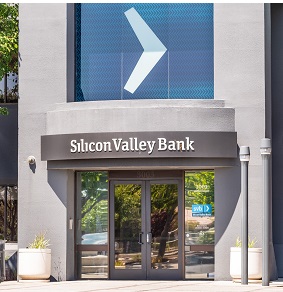Jan 04, 2026
Jan 04, 2026
 The Silicon Valley Bank, the 16th largest bank in the US that is best known for its association with high-flying start-ups of the digital world and venture capital was to suffer from one of the banking world’s oldest problems, a ‘bank run’, and suddenly pull down the shutter on last Friday, of course, at the behest of the US regulators.
The Silicon Valley Bank, the 16th largest bank in the US that is best known for its association with high-flying start-ups of the digital world and venture capital was to suffer from one of the banking world’s oldest problems, a ‘bank run’, and suddenly pull down the shutter on last Friday, of course, at the behest of the US regulators.
SVB, the Santa Clara, California-based bank that catered to the credit needs of technology companies, particularly start-ups, is the biggest bank to fail since the 2008 financial crisis. But first things first: let us examine how SVB failed. As we all know, banks accept deposits from the public with a promise to pay them back on demand and in the meanwhile lend the so-acquired funds to businesses to earn interest so that they could service their obligations to depositors in terms of interest on deposits accepted, meet their own establishment expenses, earn profit to distribute dividends to its owners, etc.
Banks thus manage their short-term liabilities (deposits) with the earnings from mostly long-term assets (loans). They thus stand exposed to the risk of the mismatch between their liabilities and assets. However, they successfully manage this risk so long as their deposit customers repose faith in them and continue to retain their savings with banks.
But once they lose faith in the ability of the bank to discharge its liabilities (pay back the deposits), depositors may rush to the bank demanding payment of their deposits. And, if all the depositors at once run to the bank asking for payment of their deposits, Bank will be forced to pull down its shutters for, no bank, as said earlier, keeps all its deposits as idle money in its till, but deploys them as loans/investments elsewhere.
In short, that was what exactly happened with SVB: reports reveal that its depositors in an old-fashioned ‘bank run’, of course, befitting to its client base in an online ride, withdrew $42 billion—almost one-fifth of its total deposits—in a single day, leaving the bank with $ 1 billion in negative cash balance.
Before proceeding further, let us look at the balance sheet of the bank to better understand the trigger for the depositors losing their faith in the bank. As of the end of December 2022, 56% of its loans stood in the names of Venture Capitalists and Private Equity companies. From the end of 2019 to March 2022, SVB’s deposits almost tripled to $198 billion, which is a record growth that outstripped the industry’s average of 37 percent. In normal times this could have been cheered up by any bank but for SVB it became a millstone around its neck.
For, come Covid-19, SVB found it difficult to deploy these funds as the demand for loans from tech companies waned. It was thus forced to deploy these funds as investments in the market. Initially, it deployed them as short-term investments. But owing to poor returns on these Available for Sale (AFS) investments and to mitigate the resulting mark-to-market losses, SVB, like any other bank in the normal course behaved, switched over to held-to- maturity (HTM) investments.
But with Fed rising interest rates, even these investments proved to be of no use. For, the value of these investments fell drastically, because they paid lower interest compared to the bonds would pay if issued in today’s higher interest rate market. Thus, the unrealized losses from these investments were reported to have been something like $ 16 billion by September 2022. So, with an equity base of $ 11 billion, SVB technically turned insolvent.
In the meanwhile, its deposit customers started withdrawing their deposits from the bank to deploy them elsewhere for capitalizing on the higher returns offered by the market. To meet this demand bank was to sell its investments and in the process booked huge losses. To fill this hole, it attempted to raise additional capital from the market but could not find investors.
Its plans to issue fresh capital and the failure thereof made customers to sense that all is not well with the bank. Once this concern emerged, it took no time for the panic to spread among its rich depositors through social media platforms. Many Venture capitalists appeared to have spread alarm through Twitter among the start-ups advising them to pull their money out immediately. This is followed by founders and CEOs sharing tweets about the alarming position at the bank among themselves/others.
The net result is: everybody, of course, did not run to the bank, instead quickly picked up their laptops, pulled up the web page, logged in, and within a few tries moved every cent in their account to a different bank within no time. As a professor rightly commented, it was not a ‘bank run’ but true to the digital era, it was a ‘bank sprint’.
Thus, by 12 p.m. of the 10th instant, the regulators have stepped in and placed SVB in receivership under the Federal Deposit Insurance Corporation. Thus came the end of a fancy bank that exclusively operated around the start-up and venture capital space spreading uncertainty across banks.
Image (c) istock.com
18-Mar-2023
More by : Gollamudi Radha Krishna Murty